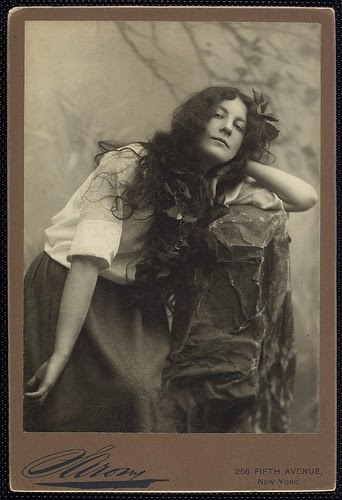 |
| Vesta Tilly - Not her real name. |
I wandered down to an antique shop I know of and their wonderful air conditioned building. As I dug around, I found a pile of amazing pictures. These weren't the random dead people photos that relatives toss out after a person passes. It was a pile of old stage actress photocards. These cards, primarily done in the late Victorian and Edwardian periods, were printed up to promote not only the actress but the next show she would be in. The actress would be often photographed in costume.
Just like our movie stars today, people were fascinated by the stage actresses of their era. In the Victorian Era, most actresses came from an acting family. This was not a glamorous job, and a thing such as comfort was unknown. Minor actresses had to take up whatever roles they were given in order to gain visibility so that they could rise to the top. They had to be tough: many worked their way through music halls, live nude shows, and harassment.
Despite the social pressure to stay home and have children, women continued to take to the boards. The U.S. census shows that from 1870-1880 the number of women who declared "actress" as their profession rose from 780 to 4,652 (an increase of 596%). By 1910 that number was 15,432 (up 332%).3 This surge of women to the stage that saw 25 new women to every one new man was signified not only economic opportunity but "social and sexual independence."4 Women obtained wealth, mobility and social power through their new found dominance in the theater.
The life of an actress, however, was not always a glamorous one. While stars could command a salary of up to $150 a week in the 1900s, most chorus or ballet girls made between ten and twenty-five. Most actors were not paid for rehearsal time and since the theater season lasted for thirty to forty weeks a year, players could usually expect long layoffs. While beauty was deemed an asset for an actress in terms of landing roles, even more important was the quality of her dress. Featured actresses were expected to supply their own costumes, which could cost between three hundred and four hundred dollars a season. Newspaper columnists often devoted a good deal of space to a wardrobe review.
Here are some of the pictures I found on Pinterest of some amazing actresses:
Sarah Bernhardt (1821-1896)
Sarah
Bernhard is one of the most famous stage and film actresses of all
time. Born in France she was referred to as "the most famous actress the
world has ever known".[3] Bernhardt made her fame on the stages
of France in the 1870s, at the beginning of the Belle Epoque period, and was soon in demand in
Europe and America. She was a serious actress and starred as Hamlet in an early
film.
 |
| Just too cool for anything. |
 |
| Relationship is code for mistress |
Lillie Langtry
LL (October 13, 1853 – February 12, 1929), usually spelled Lily Langtry when she was in the U.S., was born Emilie Charlotte Le Breton. She was a British music hall singer and stage actress. She was also known for her relationships with nobility, including the Prince of Wales, Albert Edward, the Earl of Shrewsbury and Prince Louis of Battenberg.
Lily Elsie (born Elsie Hodder; 1886–1962) was a popular English actress and singer during the Edwardian era, best known for her starring role in the hit London premiere of The Merry Widow in 1907 which this picture promoted. She began as a child star in the 1890s in music halls. Elsie built her reputation in several successful musical comedies. Afterwards, she starred in several more successful operettas and musicals. Admired for her beauty and charm on stage, Elsie became one of the most photographed women of Edwardian times.
 |
| A very merry widow has to be well dressed! |
And my personal favorite: Maud Allan.
A fellow Canadian, she was born in 1873 in Toronto and died in Los Angeles in 1956. Her real name was Beulah Maude Durrant, and she was very well educated, having studied in San Francisco, studied music in Berlin, made professional debut in Vienna, and gained stardom in London. She's recognised as a pioneer of western early modern theatre dance. This photograph is from her 1908 appearance in 'Salome' at the London
Palace Theatre. She caused a huge sensation when rumours spread that she appeared completely naked
beneath her flimsy costume for her provocative 'Vision of Salomé' dance.
 |
| She clearly is not wearing much of anything and looks like a woman who could care less what you think. |
No comments:
Post a Comment